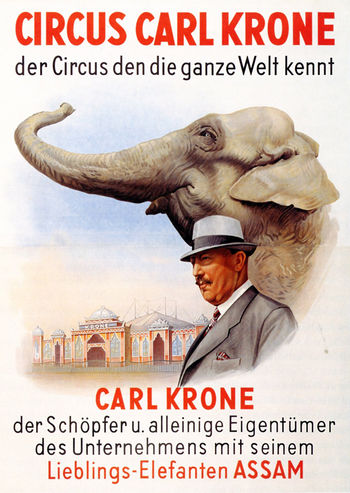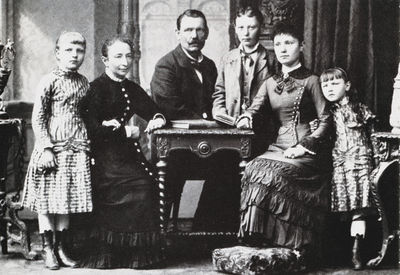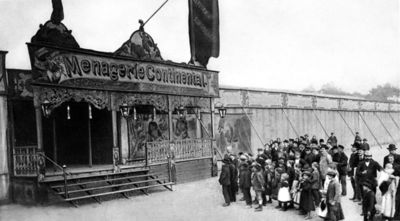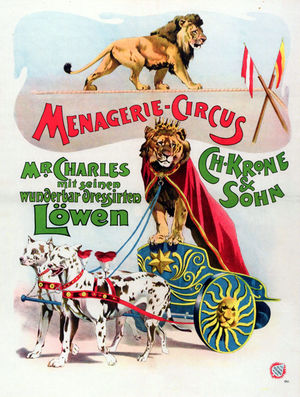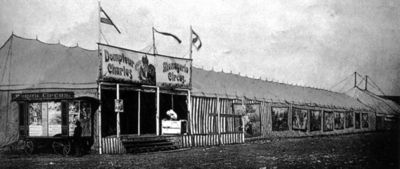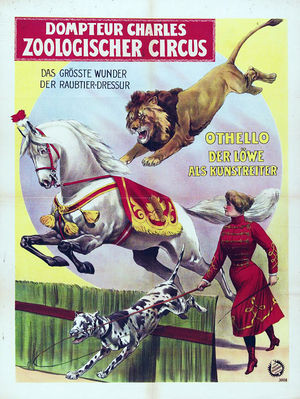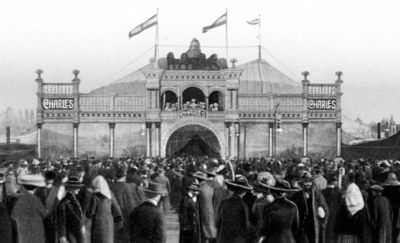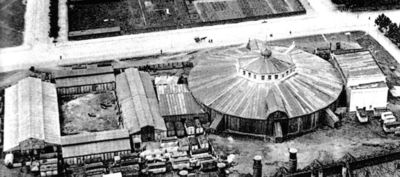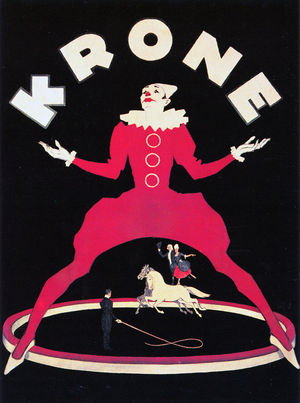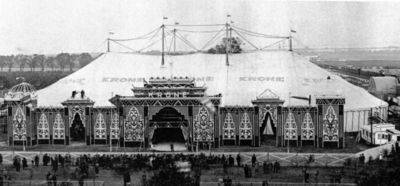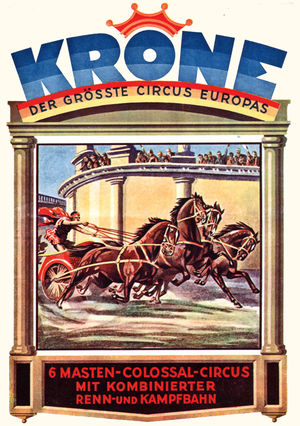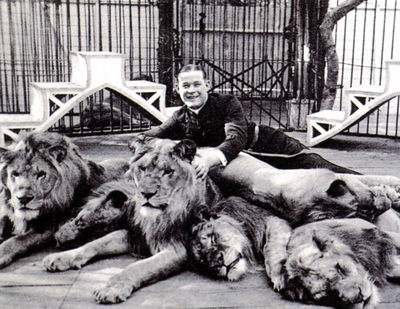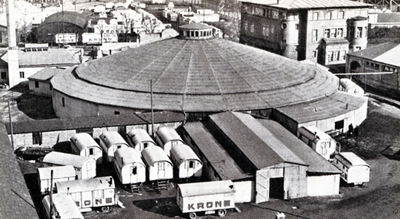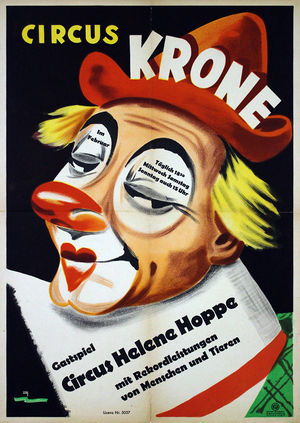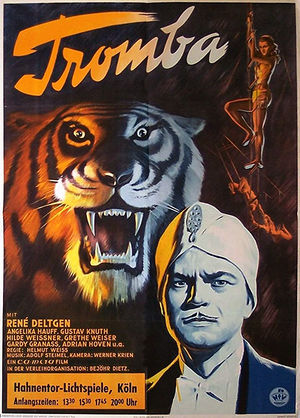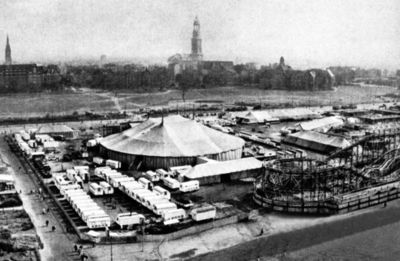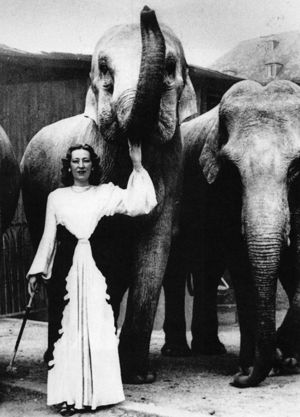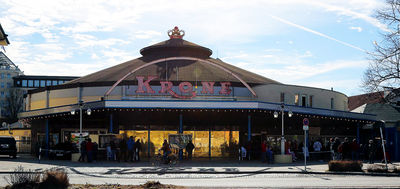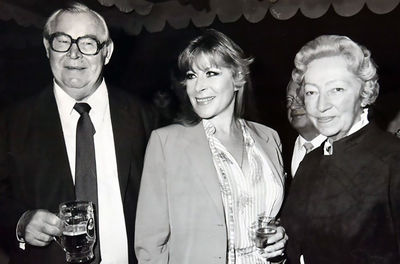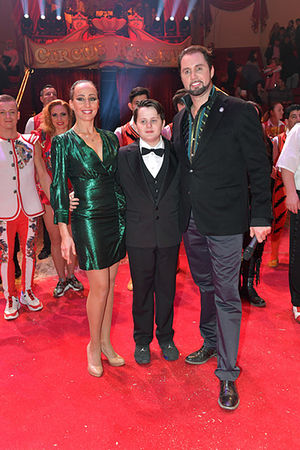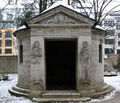Circus Krone
From Circopedia
Contents
- 1 "Größter Circus Europas"
- 1.1 Family Beginnings
- 1.2 The Menagerie Continental
- 1.3 Dompteur Charles Menagerie-Circus
- 1.4 Circus Charles: An International Vocation
- 1.5 Circus Krone and The Kronebau
- 1.6 Europe’s Three-Ring Giant
- 1.7 The World War II Years
- 1.8 Post War Struggles
- 1.9 Rebirth of A Giant
- 1.10 Krone Festival
- 1.11 Winter Strategies and The New Kronebau
- 1.12 Towards the Twenty-First Century
- 1.13 A New Era
- 2 Suggested Reading
- 3 See Also
- 4 Image Gallery
"Größter Circus Europas"
By Raffaele De Ritis
Circus Krone is the world's oldest circus company: It has been owned and operated continuously by the same family for more than a century and has maintained troughout the years the standards of quality initiated by its founder, Carl Krone, as well as its original menagerie’s heritage. Its tours in many European countries, especially between the two world wars, have established its fame beyond the confines of Germany, its homeland. In addition, under various incarnations, its permanent circus building in Munich, the Kronebau, has been home to regular winter circus productions since 1919.
Founded by Carl Krone (1833-1900), then developed by his son, Carl Krone, Jr. (1870-1943), the Krone organization typically grew from a fairground menagerie to a giant circus, according to a pattern quite common at the turn of the twentieth century in Europe, triggered by the European tour of the giant American circus Barnum & Bailey, which introduced European audiences to their first three-ring circus traveling with a full-fledged menagerie.
Yet, unlike other enterprises that followed the same model, Circus Krone’s discreet owners remained financially conservative, avoiding the dangerous ostentation of some of their colleagues; in doing so, they averted the crises and failures that had often plagued their competition. They developed international tour strategies that followed the ever-changing European economic cycles, which were strongly sustained by their successful activities in their home-based circus building, Munich’s Kronebau, established in 1919.
After WWII and the death of Carl Krone Jr. in 1943, Circus Krone became, remarkably, a woman affair: It has been first led magnificently by Frieda Krone Sembach (1915-1995), Carl’s daughter, then by her daughter, Christel Krone Sembach (1956-2017), and today by Jana Mandana Krone, Christel’s adoptive daughter—the three of them having excelled in equestrian and animal presentations as much as in circus management. Krone has proudly remained during all that time Größter Circus Europas ("Europe’s Largest Circus").
Family Beginnings
The first traces of the Krone lineage appeared in the early nineteenth century in Questenberg, a small village in the Harz mountains in the German state of Saxony (in what is today the Mansfeld-Südharz district of Saxony-Anhalt). The first registered Krone ancestor to settle in the area was Johann Anton Heinrich Krone (b.1794), who married Johanna Dorothea Wilhelmina Hempel, a resident of Questenberg, where he settled and had a son, Heinrich Wilhelm Krone. Heinrich, who was active in the 1820s as a fruit farmer, was the father of Carl Krone, also born in Questenberg on September 19, 1833; Carl (whose name was sometimes spelled Karl) is the founder of the Krone circus dynasty.
Carl’s true calling came when a traveling menagerie visited Questenberg. It was a very small affair composed of a couple of young lions and some hyenas, but it was enough to excite the imagination of farmers who had never been exposed to such exotic marvels. The traveling show belonged to Alexander Philadelphia. Friedrich Andrea Alexander Isidor Philadelphia (1811-?), who was part of a large family of traveling entertainers, was Probably the son of a Samuel Philadelphia and the grandson of the celebrated Philadelphus Philadelphia (Jacob Meyer, 1735-1795), a pseudo-scientist and entertainer, and a famous pioneer of modern magic and phantasmagoria. In any event, Alexander, after having performed as a traveling magician (as Philidor), had switched his activities to wild animal exhibition.After the Philadelphia show had left town, young Carl Krone was inspired to get a deer cub that he exhibited in country fairs and festivals. Then, in 1849, at age sixteen, he left home and joined Philadelphia's traveling menagerie. He helped the small business as "advance man"—thus making us presume that he had a basic school education. Alexandre Philadelphia (whose legal name was Meyer) and his wife, née Josepha Rosine Auguste, had six children: Albert, Rudolf, Franziska, Wilhelm, Adolf and Friederike—who all generated lineages of animal trainers and circus artists that are still active to this day. (As of 2020, Patrick Philadelphia was Circus Roncalli’s ringmaster(American, English) The name given today to the old position of Equestrian Director, and by extension, to the presenter of the show.).
Carl Krone eventually married Alexander's daughter Friederike, and the young couple began an independent life of adventures. Allegedly, Friederike and Carl Krone started touring Northern Germany in the 1850s with a small operation of their own. Traveling with just two horses and a wagon, they didn’t have any animals but exhibited "Two African Dancing Savages" (who could have been two peasants made up with black shoe polish!).
The Menagerie Continental
It is probably during the 1860s that Carl Krone's business took the shape of a small, properly structured menagerie. However, the existence of Carl Krone’s Menagerie Continental began to be documented a decade later. It consisted then of two cage wagons (containing respectively wolves and bears), and two other wagons for equipment transport and living quarters. The Menagerie Continental appears to have had regular engagements in the fairgrounds circuit; a painted façade and a mechanical organ attracted the visitors.
Carl and Friederike Krone had three daughters, Sophie, Stina and Friederike, and two sons: Fritz (1860-1887) and Carl, Jr., who was born in Osnabrück, in Lower Saxony, on October 22, 1870, and would create the eponymous circus. Fritz presented the dancing bears and performed fights with them, and Sophie and Stina worked with the wolves. As for Friederike, the youngest, she would later marry Adolf Frohn, a sealion trainer. (Their son, Adolf Frohn, Jr. (1904-1955), joined the Ringling Bros. and Barnum & Bailey Circus in 1945 before settling in Marineland, Florida in 1948 and becoming a pioneer in dolphin training and a cetacean behaviorist.)Carl Krone had different plans for his younger son: Around 1876, Carl Junior was sent to his uncle Rudolf Philadelphia, in Berlin, to get a proper academic schooling. While there, he visited with his uncle his first zoological garden and watched circus performances at Circus Renz, whose building was, at the time, Europe's largest and most magnificent. Carl rejoined his family during the holidays. However, a dramatic accident abruptly changed his destiny: His elder brother, Fritz, was killed in 1887 by one of his bears during a performance in Linum, a small village near Brandenburg, and his father called Carl back to the family business.
Young Carl had, in the past, shown a good aptitude and a passion for animal training. Already in 1886, he had taken care of the Menagerie Continental’s first elephant, a young African bull named Pluto that had been bought from a Belgian menagerie, and who survived only two years. Upon his definitive return to the menagerie one year later, Carl Junior briefly managed his own reptile exhibition. However, after Fritz’s fatal accident, Carl senior had forbidden his younger son to perform with wild animals.
Carl Junior had other ideas! When, in 1889, the legendary cat trainer(English/American) An trainer or presenter of wild cats such as tigers, lions, leopards, etc. Julius Seeth (1863-1939) gave the family a litter of lion cubs that he couldn't take with him to an engagement with Circus Ciniselli in St. Petersburg, Russia, Carl Junior jumped on the opportunity to develop in relative safety a small act—and, in the process, a new performing persona destined to great success: "Dompteur Charles." Thus, with his distinguished French name and an elegant military-style costume replete with a frogged jacket and leather boots, Carl joined the pioneering generation of German animal trainers who were redefining the circus presentation of cage acts for the twentieth century.
In 1892, Krone's Menagerie Continental (also titled at some point Krones Zoologische Ausstellung) visited Hamburg. One of the world’s largest port city, the northern metropolis was becoming at the time a circus, variety and traveling entertainment mecca. Besides important legitimate and variety theatres and circus buildings, the city's immense Heiligenfeld was a major international venue for fairground operators. In addition, as a major epicenter of international maritime commerce, it had been for two centuries an important marketplace for menagerie operators, small and big.Among them, Hamburg’s own Hagenbeck company was becoming synonymous with foreign exoticism, pioneering the trade of wild animals imported from the four corners of the world, and inventing the modern urban zoo—to all of which they added the importation and exhibition of "exotic" tribes from the far-away lands of America, Asia and Africa. The Hagenbecks had also just started to experiment in a new area: the modern training of exotic animals.
Carl Hagenbeck (1844-1903) and his brother Wilhelm (1850-1910) had developed two separate, yet collaborating, companies. After having absorbed most of the last remaining menageries of central Europe, they were forming a new generation of wild animal trainers that forsook the old concept of wild animal "tamers" to develop the Hagenbeck style, which put the emphasis on displaying the animals’ natural abilities. Two of Wilhelm Hagenbeck's early key collaborators were the aforementioned Julius Seeth, and Wilhelm Philadelphia (1854-1921), Carl Junior's uncle.
While in Hamburg, Carl Junior entered in contact with them, and learned about Hagenbeck’s last sensational creation: The riding lion. Philadelpia and Seeth had trained a young lion to ride a horse around the ring. This attraction(Russian) A circus act that can occupy up to the entire second half of a circus performance., documented for the first time in 1889 when it appeared at Paris' Hippodrome de l'Alma, was probably the principal reason for one of circus history's major technical innovations: the circular cage made of removable panels, developed by the Hagenbecks. The riding lion became all the rage in the industry: In a few years, Wilhelm Hagenbeck was able to deliver twelve different versions of the act in Europe, U.S.A. and Australia.
Carl Junior saw in the Riding Lion a perfect attraction(Russian) A circus act that can occupy up to the entire second half of a circus performance. for his family’s growing menagerie and asked Wilhelm Hagenbeck to provide the Menagerie Continental with yet another version of his act; Hagenbeck accepted, probably estimating that Krone’s relatively modest menagerie business wouldn’t be a competition to the big international shows with which the Hagenbeck companies were dealing. From Wilhelm Hagenbeck, Carl also acquired two other classics of the Hamburg training factory: A rope-walking lion, and an attraction(Russian) A circus act that can occupy up to the entire second half of a circus performance. titled Der Triumph—a lion, regally attired in a red cape and wearing a crown, standing in a Roman chariot drawn around the cage by two great Danes.
Carl had a Hagenbeck-style circular cage built, and he set it up, surrounded by boxes and bleachers, under a new two-pole circus tent adjacent to the oblong structure of the traveling menagerie. Carl Krone junior is generally credited with a successful improvement on the Hagenbeck’s original circular cage: The addition of steel-tunnel elements that connect the cage wagons to the steel arena. Thus equipped, Carl presented the Hagenbeck acts to the menagerie visitors, who had to pay an extra fee to watch the performance.
Dompteur Charles Menagerie-Circus
Now titled Dompteur Charles Menagerie-Circus, Krone’s new, enlarged operation opened in Kiel in 1898. It had become a significant affair: Animals cages were set-up under a 100-meter-long narrow tent with a painted front, and the entire operation moved with fifteen transport, living and cage wagons. More animals were gradually added to the collection: A leopard, a few monkeys, a pelican, two performing seals... The purchase of four young polar bears provided an additional act for the exhibition tent. (Polar bears would be a fixture of Krone’s circus shows for a large part of the twentieth century).In 1899, young Carl, with Carl Senior’s consent, toured his own animal exhibition independently from his father's menagerie. It didn’t last long: Carl senior passed away on February 1, 1900 in Frankfurt an der Oder, and Junior had to take over the family business—which was 24,000 marks in debt. It was the beginning of a new era that would see the true birth of what was to become the mighty Circus Krone.
During their stay at Hamburg’s Heiligenfeld, the Krones had set up their Menagerie Continental near Ahlers’ Affentheater, a traveling monkey theater. Monkey theaters were quite popular at the time, and Ahlers show was one of the most successful in Germany. Its owner, Benuas Ahlers (1850-1940), known as Benoit, presented with his family a show consisting of costumed primates of various species performing small pantomimes on a fully equipped theater stage.
Benoit Alhers had a daughter, Ida (1876-1957), born on the road on November 3, 1876. Over the years, the Krones and the Alhers had often worked on the same fairgrounds, and they had become friends. Ida was pretty and she and Carl eventually fell in love. Carl was thirty-two when he married the 26-year-old Ida Ahlers in Koblenz, in 1902. The two families were now one and, quickly thereafter, Krone absorbed the Ahlers show. Benoit Ahlers, now Carl’s father-in-law and partner, was soon to start Circus Krone's fabled equestrian tradition.At that time Carl Krone's Dompteur Charles’ Menagerie-Circus had become a major fairground attraction(Russian) A circus act that can occupy up to the entire second half of a circus performance.. The huge menagerie needed now up to three days to set up. Its façade had been upgraded with attractive wood carvings, the mechanical organ had given room to a six-piece band, and colorful posters were created by Europe's finest printer of circus advertising, the famous Adolph Friedländer of Hamburg (whose elegant, colorful and beautifully designed posters have become today a collector’s delight). This investment in printed advertising suggests that Carl Krone’s attraction(Russian) A circus act that can occupy up to the entire second half of a circus performance. had become strong enough to move from the basic fairground economy of its beginnings to that of a major itinerant enterprise.
The new Mrs. Carl Krone, Ida, who had been used to working with monkeys, showed a remarkable ability at training large wild animals; as "Miss Charles," she became, under her husband’s tutelage, one of the most remarkable female animal trainers of her times. Just a few months after her marriage, she debuted in the big cage with Krone’s group of polar bears—the lady who usually presented them having left the show abruptly—and replaced Carl in the Riding Lion act. Eventually, Ida specialized in lion acts and, by 1908, she presented a spectacular group of 14 lions. Souvenir postcards of the time depicted her surrounded by those magnificent male lions forming a pyramid on beautifully designed Art-Deco props.
The performances in the steel arena offered by the Menagerie Charles made the "fighting" style of presentations of the old traveling menageries a thing of the past. By 1904 the show was titled Dompteur Charles Zoologische Circus, a denomination ("Zoologische Circus") that had been previously used by Wilhelm Hagenbeck’s touring show. The following year, Carl added a group of twenty horses to the show, which formed Benoit Ahlers’s new equestrian department. Carl Krone’s enterprise was on its way to become a legitimate traveling circus.
Circus Charles: An International Vocation
At the turn of the twentieth century, Germany began to shape the model for Europe’s animal-based traveling circus, which would define most of the new century. The fading of itinerant menageries, the success of Hagenbeck's new style of animal presentations, and the impact of the Barnum & Bailey Circus’s European tour of 1897-1902 had prepared the ground.There were already European traveling circuses then, such as Corty-Althoff, a well-known and respected traveling circus owned by Pierre Althoff, which presented classic equestrian circus shows under round big tops or wood-and-canvas "constructions" that tried to emulate the elegance of urban circus buildings. The first German itinerant circus to adopt the "sensational" and "giant" aspects of its American counterparts would be Circus Sarrasani, which had been created in 1902.
On May 28, 1905, the Dompteur Charles' weltberühmter zoologischer Zirkus Riesen-Wander-Menagerie und Affen-Theater ("World Famous Zoological Circus, Traveling Menagerie and Monkey Theatre"), Carl Krone's new traveling venture, opened in Bremen. The new tent, which was slightly elliptical (the European standard of the time) and sustained by two main poles, had a reported diameter of 36 meters—which probably referred to its longest axis (the first perfectly circular big tops would not appear before the early 1920s). It had an advertised capacity of 3,000 spectators—who would have been, if this figure is true, crammed on narrow and very uncomfortable bleachers when the house was full!
The performances still consisted solely of animal acts, including the horses presented by Benoit Ahlers, the old polar bear act, Hagenbeck's lion acts presented by Carl or Ida, plus guest acts such as the mixed animal group of Miss Cora (a menagerie celebrity of the time) and the cat trainer(English/American) An trainer or presenter of wild cats such as tigers, lions, leopards, etc. Scheepers—all accompanied by a fifteen-piece orchestra. The menagerie adjacent to the circus could be visited during the day for 30 Pfennigs; it advertised twenty-four lions (Ida, however, was not listed in the performer roster), a couple of elephants, a tiger, black and spotted leopards, pumas, dingoes, wolves, polar bears, a zebra, camels, bighorn sheep, zebus, snakes, crocodiles, ostriches, exotic birds, etc.
Traveling by rail, the circus then moved North, and then left Germany to visit Copenhagen in Denmark. Like most of the other fast-growing German itinerant circuses, Krone soon developed international tours: in 1907, it went to Brussels, then Prague (as Cirkus Koruna: "Koruna" is the Polish translation of Krone—which means "crown" in English). In the following years, the circus traveled on sixty railway cars, and its tent grew first to a diameter of 48 meters, and then 52 meters, doubling its announced seating capacity to 6,000.
The show, its advertising and organization were evidently following the models set by Hans-Stosch Sarrasani and the Hagenbecks (the two German trend-setters of the era). Like them, Krone imported large "exotic" troupes (Moroccan, Chinese and Native American notably), added a Wild-West segment to the show, and had a huge façade built, which emulated Sarrasani’s. Like Sarrasani, Krone also began to use steam tractors to move wagons back and forth between the train depot and the circus lot. Progressively, Carl Krone added traditional circus acts to his animal roster.In July 1909, Circus Charles tried its luck for a few weeks in Berlin. In Germany’s entertainment capital, home of the famed Renz and Busch circus buildings, Carl Krone got the opportunity of having his circus recognized on the national entertainment scene. "Miss Charles" topped the bill with her group of fourteen lions. Ida would present her lion act until 1913 but, after a minor accident, she would be definitely replaced in the cage by Heinrich Wagner, a well-known cat trainer(English/American) An trainer or presenter of wild cats such as tigers, lions, leopards, etc.. Henceforth, Ida would assist her husband in the management of the circus, overseeing its vast animal collection.
In 1913 Circus Charles visited Budapest. In 1914 Carl Krone, who was now presiding over a sizeable circus whose stables hosted no less than eighty horses, decided to visit France, via Belgium; the show opened in Lille, not far from the Belgian border, where bad initial business soon gave room to open hostility: In spite of its French title, French audiences quickly discovered that Cirque Charles was actually a German enterprise. The Franco-German war of 1870 and the loss of Alsace and Lorraine to Prussia had remained an open wound!
Krone quickly retreated, heading to Wien, the Austrian capital. But on July 23, 1914, as the circus was performing in Ljubjana (in Slovenia, which was then part of the Austrian-Hungarian Empire), Austria declared war to Serbia, and four days later, Europe was at war. Men were drafted to the Army and the company temporarily dissolved. To make matters worse, dozens of horses were killed to respond to food shortage.
Circus Krone and The Kronebau
Finally, the circus was able to reach Wien. Circus Charles faced in the Austrian capital the same problem it had experienced in France, but in reverse: the French name Charles triggered the hostility of the Viennese. Carl Krone had paper bands printed in a hurry to cover the circus’s French name and, on September 26, 1914, Circus Krone appeared for the first time on the posters and everywhere else. Carl declared: "In an effort to clean our language from foreign and French words, I announce that I have dissolved my society, Circus Charles, and will use the name CIRCUS KRONE in the future." The circus wagons were quickly repainted in white with the name Krone in red letters.
By November, the circus played in Wien's Busch circus building, and staged a war-propaganda pantomimeA circus play, not necessarily mute, with a dramatic story-line (a regular feature in 18th and 19th century circus performances). (as Sarrasani had done a few months earlier in its circus building of Dresden), which was followed by a Christmas program. Circus buildings in large cities provided a good resource for large traveling circuses suffering from a shortage of workers during the war years. (Krone would also play the Busch buildings in Berlin and Hamburg the following year.) It is in Wien that, on April 15, 1915, Carl and Ida Krone welcomed their daughter, Frieda.
Meanwhile, the menagerie kept growing. In 1916, Krone acquired the giraffe Marguerite, the hippopotamus Nora and the young rhinoceros Lisa (none of which were performing): It was the first European circus to exhibit these three specimens together. A boxing kangaroo act also became a new feature of the show, and a new generation of wild animal trainers appeared in Circus Krone’s ring: Heinrich Wagner was joined by Fernand Montbaron and Alfred Bendix. Wagner was a sensation with his group of fifteen tigers, a group of five polar bears and Krone’s large herd of seven elephants.Nonetheless, touring was increasingly hard, with food rationing for men and animals and dwindling audiences. Krone’s horses and elephants were employed in military service operations, as was the case for many circuses of the time. The First World War finally ended in 1918. In early 1919, an epidemic of equine fever obliged the circus to stop in Munich, and Carl Krone saw there an opportunity to invest in a piece of land where the circus could build its winter quarters.
He found a large lot of 30,700 square meters longing the central Marsstrasse, one block from Munich’s train depot, and asked the architect Josef August Ruprecht to build a wooden circus that could seat 4,000 spectators. It would be later completed with wooden annexes to house the vast menagerie (designed on the pattern of the traveling circus’s tent set up) with, opening on Marsstrasse, a stone building fronted by a monumental façade of non-descript modern style, oscillating between the neo-classical (with its columns and lintel) and the upcoming Bauhaus. The lintel proudly displayed the title Gross-Circus-Schau-Krone.
The circus itself was quickly built and opened on May 10, 1919. Even though, with the exception of its frontage, the finished ensemble would remain a relatively basic and cheap structure, far from the magnificence of Sarrasani’s Dresden building or the other circus buildings scattered throughout Germany and Austria by Paul Busch and Albert Schumann (and Ernst Renz before them), the Krone-Bau (or Kronebau), as Circus Krone’s Munich building was to be known, was the largest showplace in the city, and would quickly became a Munich landmark. To advertise it, the famous Jugendstil caricaturist and designer Willy Hallstein (1887-1923) created in 1920 a poster featuring a romantic white-face clown that became Circus Krone’s most iconic poster.The Kronebau became a precious resource, not only because it housed the circus with its equipment and menagerie during the winter months, while giving it the possibility to perform in the warmth of a building, but because it was rented for various events during the circus’s absence, helping to balance the budget of its expensive tours—especially when the season was not as fruitful as expected. In 1926, Carl Krone had an elegant mansion built contiguous with the Kronebau’s front building, the Villa Krone, where the family still lives to this day (as of 2020). The side street at the corner of which it stands was renamed Circus Krone Strasse in 1967.
During the economic and societal transformations of the post-WWI years, Munich became a political hotbed. Being the city's largest venue, the Kronebau was a choice location for civic, political or religious organizations to host big meetings with famous orators—from the future pope Pius XII to Adolf Hitler addressing a large public meeting of the Nazi Party on February 3, 1921.
However, the galloping inflation that plagued Germany after the war eventually forced largest German circuses to find new markets abroad. Krone was not immune and, in 1921, it embarked on a tour of Italy. After initial boycott attempts from the local competition, the circus was well received: In Turin, it received the visit of King Vittorio Emanuele III, who rewarded Carl Krone with the title of Commander of the Kingdom; in Rome, a young journalist introduced himself to Carl: His name was Benito Mussolini. The Italian tour went as far down as Sicily and lasted three years, ending in the spring of 1924. It was a financial success, and the circus returned to Germany via Switzerland.
Europe’s Three-Ring Giant
Upon his return, Carl Krone found an economic situation that had worsened. In 1923, Hans Stosch-Sarrasani had decided to try his luck elsewhere and had been able to arrange the first South American tour of his huge Circus Sarrasani; the following year, the once-glorious Circus Corty-Althoff had been obliged to fold its tents. However, now flush with foreign currency, Carl Krone chose to quickly re-invest his liquid assets into the further development of his already large enterprise.
The German circus tradition had long focused on equestrian-based programs: the big topThe circus tent. America: The main tent of a traveling circus, where the show is performed, as opposed to the other tops. (French, Russian: Chapiteau) experience had just been a traveling reflection of the circus buildings' classic shows and elegant formats. Indeed, the arrival of menagerie owners into the legitimate circus business had reshaped it in the first decade of the twentieth century, with the heavy presence in the shows of wild and exotic performing animals. In the early 1920s, audiences began to expect to see at least three different cage presentations and several displays of exotics animals in a large traveling big topThe circus tent. America: The main tent of a traveling circus, where the show is performed, as opposed to the other tops. (French, Russian: Chapiteau).The pioneering Sarrasani had begun to revive Barnum & Bailey and Buffalo Bill memories with its Wild West exhibitions and its American-style advertising (which it had already started in 1906, during the Buffalo Bill's Wild West’s last European tour). Whereas Krone had appeared for a while to simply follow in Sarrasani's footsteps, his new project was to reset the European circus industry's standards by further reviving the still vivid memories of the Barnum & Bailey’s European tours of two decades earlier.
On August 29, 1924 in Augsburg, northwest of Munich, following rehearsals in Lausanne, Carl Krone premiered the first ever European three-ring circus. The huge four-pole tent of 52 x 85 meters contained a hippodrome track surrounding three rings where simultaneous displays were presented. Among its 71 displays, the program included no less than seven cage acts, with sixteen equestrian acts for good measure, among which a spectacular sixty-horse carousel. “Herrn Direcktor Carl Krone” presented his ever-growing herd of elephants, which would eventually reach twenty-seven heads. After the end of the performance, spectators were invited to watch the Stey Family performing outside the tent on the high wireA tight, heavy metallic cable placed high above the ground, on which wire walkers do crossings and various acrobatic exercises. Not to be confused with a tight wire..
Billed as The Greatest Show of the Continent, Krone balanced American magnitude and European standards—in both animal presentations and the quality of other acts. European-style big topThe circus tent. America: The main tent of a traveling circus, where the show is performed, as opposed to the other tops. (French, Russian: Chapiteau) comfort also prevailed, with a large lobby tent behind the façade, and ten covered staircases all around the tent, leading to relatively comfortable bleachers. The gigantic, ever-growing menagerie (which was likely, at the time, the most complete in the circus world) was open all day and could be visited for an additional fee.Circus Krone reached its maximum size in 1926 and 1927 with a 10,000-seat, six-pole tent that housed three rings interspersed with two stages, like the giant Ringling Bros. and Barnum & Bailey in the United States. But the show format began to fundamentally differ from its American model: At mid-show, during an aerial production tableau, the rings and stages were dismantled, and the remaining of the show was given on the huge, sixty-two-meter long hippodrome. It included Carl Krone’s group of twenty elephants, Roman chariot races, the Wild West production, and various themed tableaus and parades that included sometimes exotic animals and a ballet of eighty showgirls.
Meanwhile, in 1925, Circus Sarrasani returned from South America, and Hans Stosch-Sarrasani began what can be considered the most ambitious circus modernization project of the times (see The Rise and Fall of The New Sarrasani), which would deeply influence the industry. Krone had immediately followed suit, improving, as we have seen, his infrastructure and his shows.
In 1929, the Heinrich Mack Company of Waldkirch, Germany’s premier coach builder, furnished Circus Krone with a new series of custom-designed wagons, including a luxurious living wagon for Carl and Ida Krone, and Carl purchased a new, revolutionary tent supported by four poles in square plus two poles in line at each end, which cleared the hippodrome of any obstruction (the circus was back to a simple three-ring format), and which was fronted the following year by a monumental "oriental," 120-meter-long façade, directly inspired by Sarrasani's.Krone’s three-ring format, its vast menagerie, and the success it obtained quickly inspired the competition: Popular circuses such as Strassburger, Blumenfeld and the newcomer Gleich, as well as the Czech Kludsky (whose huge menagerie was even larger than Krone’s) converted to the three-ring format. Gleich and Kludsky would go bankrupt in the process; as for Strassburger and Blumenfeld, two enterprises owned by respected Jewish circus families, they didn’t survive the rise of Nazism.
However, the fiercest competition opposed Krone and Sarrasani: Their feud would become the stuff of legend. Their styles were different (the giant Sarrasani had pioneered the use of a four-pole-in-square, perfectly round big topThe circus tent. America: The main tent of a traveling circus, where the show is performed, as opposed to the other tops. (French, Russian: Chapiteau) with a single ring), but their shows rivalled in grandeur, and their menageries were comparable. French circus historian Henry Thétard listed Krone’s menagerie lineup in 1934: "250 horses or ponies, 27 elephants, 24 camels and dromedaries, 20 zebras, about thirty buffalos, bison and zebus, llamas, donkeys, antelopes, goats, 40 lions, 36 tigers, 54 bears, wolves, jackals, mastiffs, 2 hippos, 2 giraffes, 2 sea elephants, 12 sealions, about one hundred monkeys, many snakes and even more birds…"
Yet, Germany’s dreadful economic situation still obliged Krone (and other large German circuses) to travel abroad. In 1927-28, it visited Spain: Southern Europe had never been visited by Barnum & Bailey, and the sight of the German colossus stunned Spanish audiences. Announced by lavish street parades, the show was immensely successful and changed forever the Spanish perception of the circus. The royal family attended a performance in Madrid and, during the circus’s stand in Bilbao, a six-year-old kid named Arturo Castilla found his vocation under the German big topThe circus tent. America: The main tent of a traveling circus, where the show is performed, as opposed to the other tops. (French, Russian: Chapiteau) and, within a few decades, would become the producer of one of Europe’s largest and more spectacular circuses.
In 1929, the German press saluted an official "armistice" between the two moguls of the German traveling circus, Carl Krone and Hans Stosch-Sarrasani, likely orchestrated by circus writer and press agent A.H. Kober: It was announced in a dual press conference in Hamburg that Sarrasani officially held the title of "Most Famous Circus of the Two Worlds" and Krone that of "Europe’s Greatest Show." The event proved an excellent publicity for both circuses, and the latter truly deserved its title: Krone was indeed Europe’s largest (and most successful) circus, with its eight hundred employees and two special trains that carried three hundred transport and living wagons and six hundred animals.
The World War II Years
In spite of his success, Carl Krone eventually came to recognize that running a three-ring circus was very costly, especially since the ripple effects of the Wall Street crash of 1929 were reaching Europe. By 1930, growing costs, not only in Germany but also in the rest of Europe, were threatening the fortune he had gathered during his successful foreign tours, and increasing ticket prices in that economy was not an option. Carl Krone thus abandoned the three-ring format for a lighter show given on a single ring and the hippodrome. The circus survived by touring countries where inflation was more or less under control: Austria, France, Hungary, the Netherlands.In 1931, the circus’s size was again reconsidered, and the tours alternated the use of the hippodrome tent with that of a classic four-mast-in-square, round big topThe circus tent. America: The main tent of a traveling circus, where the show is performed, as opposed to the other tops. (French, Russian: Chapiteau), which allowed the circus to visit smaller towns with quicker moves, thus reducing the number of days lost. By 1938, Carl Krone had definitely adopted the latter format. He had surely observed with attention the fate of his three-ring competition: Kludsky went bankrupt in 1934, and Gleich, which had downsized to a single ring that same year, folded its tents in 1937. (Blumenfeld and Strassburger had sadly left the game in other, more tragic circumstances in 1928 and 1935, respectively.)
On September 1, 1939, World War II began. Soon, numerous restrictions impeded circus tours and Carl Krone concentrated most of his activity in Munich’s Kronebau. Its programs, which were renewed almost monthly, lost much of their cosmopolitan quality: German variety and circus companies were forced to limit their talent search to the Axis's European countries, Germany, Austria or Italy. Meanwhile, the new Krone generation was emerging. On December 7, 1935, Frieda Krone, who had brilliantly made her debut in the ring as a high-schoolA display of equestrian dressage by a rider mounting a horse and leading it into classic moves and steps. (From the French: Haute école) rider two years earlier, married the cat trainer(English/American) An trainer or presenter of wild cats such as tigers, lions, leopards, etc. Carl Sembach (1908-1984); eleven months later, on November 27, 1936, Frieda gave birth to their daughter, Christel Krone Sembach, in Munich.
Carl Sembach, who was born on December 8, 1908 in Frankfurt am Main, didn’t come from a circus family: He was the son of a Tax Inspector. Since childhood, he had nurtured a passion for zoology, and wild cats in particular. On the occasion of his tenth anniversary, he had been presented with a year-long pass for the Frankfurt zoo, which he began to visit regularly. He became eventually a zoo volunteer, and later attended the zoo’s animal training school.
Tall, calm, elegant, he had all the qualities to become a performer. In 1928, he was sent to the Czech Cirkus Konrado of Rudolf Konrad with a group including three tigers, a tigon, a lion and three lionesses. He performed with that group in the Baltic states until 1931. The following year, he went to perform at Traumland ("Dreamland"), a Berlin’s amusement park, until Carl Krone entrusted him with a group of fourteen lions that had been previously presented by Richard Havemann, and sent him at the end of 1932 to perform for eighteen months as a guest artist with the Russian State Circus organization (GOMETs).Upon his return, Carl Sembach went on to perform at Circus Krone, where he caught Frieda Krone’s attention. Carl and Ida Krone welcomed his marriage to their daughter on one condition: Carl Sembach had to give up cat training, which was deemed too dangerous for someone who was to become their daughter’s husband and, eventually, partner. Sembach reconverted to the European circus aristocracy’s specialty of choice, equestrianism—and would become in the process one of his generation’s finest horse trainers.
In 1937, the family had bought a large farm in the town of Wessling, west of Munich, where they could house their horses and exotic animals. This would prove a vital resource during the war, when frequent allied bombing hit Munich. The farm was not big enough to house the elephant herd, however, and the fifteen remaining pachyderms found refuge in a former brewery in Bad Reichenhall, near Salzburg. The Kronebau’s stables housed only the horses of equestrian guest acts, and animals that were absolutely necessary for the show.
Carl Krone wouldn’t see the end of the war: He died in Salzburg, after spending time with his elephants in nearby Bad Reichenhall, on June 4, 1943. He was seventy-three. The ownership of the circus passed on to Ida Krone, and Frieda and her husband took over its management; although they would become the most prestigious directorial couple of the second half of the twentieth century, they first presided over Circus Krone’s darkest period—starting with the bombing and destruction of their Munich’s Kronebau in the night of December 12, 1944.
Post War Struggles
After the German capitulation of May 7, 1945, Germany was a country in ruins, with nowhere to tour a circus. Frieda and Carl set their mind to rebuilding the Kronebau as quickly as possible. They managed to find wood and, with more difficulty, iron nails and bolts. Meanwhile, the U.S. occupation forces wanted to stage a circus show for the sixtieth anniversary of General Patton (who had just been demoted from his Munich command post), and they were advised to ask the most powerful circus family of the Pre-War era, Krone.
The Krones still had their animals and found artists eager to work, and they managed to put together a huge show at the Olympia-Eisstadion of Garmisch-Partenkirchen on November 11, 1945. With this stroke of luck, Krone was back on the map and, soon after, on Christmas Day, December 25, 1945, the Kronebau’s second incarnation, a hastily built wooden building that could accommodate 1,800 spectators, opened its doors on Marsstrasse. Yet, the Krone family was not out of the woods!In 1932, Carl Krone had been the object of allegations that he may have had Jewish origins—perhaps because the Philadelphia branch of the family, whose real name was Meyer, had looked suspiciously Jewish to a zealous Nazi believer. This was indeed not something to be taken lightly: In 1929, the once respected and popular Jewish circus Blumenfeld had been boycotted and forced into bankruptcy. Even though, like the vast majority of circus people, he had never been involved in politics, Carl Krone followed thousands of industry leaders and joined the NSDAP (the Nazi Party), feeling it would be safer for himself, his company and his employees.
This uncomfortable past resurfaced during the Allies’ early occupation of Germany. One of their preoccupations was to “de-nazify” the German people, and it was established that Circus Krone was one of the German companies that had to be sanitized. The Krones initiated a lawsuit to clarify the family’s activities during the Nazi period. Nonetheless, they were deprived of their own circus, and the new Kronebau’s management was given to a minor impresario with correct credentials from the occupants’ point of view, Helmut R. Buttner; the Krone family were allowed to perform with their animals, which remained in their ownership.
Then, in the spring of 1946 the American command abruptly ordered the family to quit the premises, and both their circus and their house were confiscated. The Kronebau went under the management of the German circus director Oskar Hoppe, who was at the time president of the Union of German Circus Owners and had been labelled "politically unreliable" by the Nazis, which made him politically suitable to the Occupation Forces.A ubiquitous character of the post-war German circus, Hoppe (who had married five times) had managed mostly other peoples' circuses. After having been the administrator of Dominik Althoff’s circus, he had married Althoff’s daughter Helene (the sister of Carola and Franz Althoff) and got control of her circus, which was renamed in 1940 Circus Helene Hoppe. Some surviving posters of Hoppe’s time at the helm of the Kronebau read "Krone presents Helene Hoppe Circus." (Ever the opportunist, Oskar is rumored to have proposed Frieda to divorce Carl Sembach and marry him in order to get back the control of her Kronebau!)
Deprived of their circus and their Munich home, but not of their farm and their animals, the Sembachs survived as performers: They spent the 1946 season at Circus Franz Althoff, where Frieda presented her high-schoolA display of equestrian dressage by a rider mounting a horse and leading it into classic moves and steps. (From the French: Haute école) act and Carl, putting aside momentarily his wedding wows, presented Krone's tiger group. This situation didn't last a year: Their lawsuit finally demonstrated the non-involvement of the Krone enterprise in Nazi politics, and the family got back their circus building and their house. (Hoppe eventually got control of Circus Busch-Berlin, the remnant of Paula Busch’s traveling circus—which would later merge with Circus Roland—then, in 1961, leased the Willy Hagenbeck title; he died in 1969, leaving the latter circus to his fifth wife, Ingrid.)
By then, however, the Krones didn’t have enough resources to revive the Kronebau, let alone take their traveling circus on the road. In 1948 Carl and Frieda returned to the fairgrounds of their origins for Munich’s Autumn Festival, which, since the beginning of the war, had replaced the Oktoberfest (which would be revived the following year). They improvised a menagerie, provided pony rides for children, and made good use of their animals in every possible way.
It was a big success, which allowed them to reopen the Kronebau with a folk festival, Bayern Rhapsodie. Bayern is the German word for Bavaria: The show was thus symbolic of Bavaria’s rebirth, and Munich’s audiences packed the house for seven weeks. This event resuscitated Krone's popularity. With the money made, Carl and Frieda could at last restore the old circus wagons that had been damaged during the bombings, order new ones and purchase a new big topThe circus tent. America: The main tent of a traveling circus, where the show is performed, as opposed to the other tops. (French, Russian: Chapiteau).
Rebirth of A Giant
The afterwar saw a deep transformation of the German circus scene. All the giant circuses of the past had disappeared, as well all as the glorious circus buildings. Only the Kronebau had been rebuilt, and Harry Barlay had installed a permanent "construction(French) A temporary circus building, originally made of wood and canvas, and later, of steel elements supporting a canvas top and wooden wall. Also known as a "semi-construction."" on the Friedrichstrasse in Berlin, but its existence was short-lived. Yet, like everywhere else in Europe, the post-war years proved a boon for the circus business, and about 150 small- or medium-sized traveling circuses were soon roaming the country—some of which would eventually be stuck in Soviet-controlled East Germany.
The Althoffs, Germany’s oldest and largest circus dynasty, which had remained active during most of the war years (even though they never adhered to the NSDAP), hit the road again with two circuses of outstanding quality: Franz Althoff's huge eponymous circus (which would be the only one to revive the pre-war three-ring practice), and his sister Carola's Circus Williams, which she ran with her British/German husband, Harry Williams. The Hagenbecks had also kept their operations alive. And now, at long last, the itinerant Circus Krone readied itself for the 1949 season.Circus Krone resumed its tour—"From the Alps to the North Sea," as the advertising proudly announced—with two special trains carrying 250 transport, living and cage wagons, and a smaller, but still important menagerie including nine elephants. The huge four-poles-in-square new tent, sixty-five meters in diameter, visited twenty-five cities. The three-hour-long show included the equestrian presentations of Carl Sembach, which would quickly become a highpoint of Krone’s programs, and the new, brilliant triple high-schoolA display of equestrian dressage by a rider mounting a horse and leading it into classic moves and steps. (From the French: Haute école) act of Carl and Frieda Krone Sembach with their young daughter, Christel.
The tour was an enormous success, and Krone’s popularity got another boost with the release in 1949 of a German movie shot in the Kronebau, Tromba, directed by Helmut Weiss (released in the U.S. under the title Tromba The Tiger Man in 1952); this "film noir" about a tiger trainer became Germany’s top-grossing movie of the year. The tiger trainer Ernst Tischer had served as the actor René Deltgen’s understudy in the film’s sequences with the tigers. Thereafter, Frieda and Carl Krone Sembach had Tischer costumed as the movie character and presented him in their show as "Tromba The Tiger King."
Within a few years, the circus was able to refresh its fleet of vehicles, build a new monumental façade and, to keep on with its tradition, significantly enlarge its menagerie. Krone also renewed its tiger group and created two new cage acts, with polar bears and lions. Carl Sembach was revealing his directorial gifts and began to develop an international vision for the circus. He traveled regularly in Europe, where he acquired the respect of the restricted Gotha of the great European circus families, and his diplomatic tact helped him prepare the grounds to resume Circus Krone’s foreign tours.
Krone was one of the few European circuses that were not forced to stop its activities during the winter, thanks to its building in Munich, where it offered three different circus shows during the winter months. Nonetheless, Germany was still emerging from a physical and economic catastrophe, and Sembach continued to look for opportunities to have the big topThe circus tent. America: The main tent of a traveling circus, where the show is performed, as opposed to the other tops. (French, Russian: Chapiteau) touring abroad. In the winter of 1953-1954, he was able to organize a tour in Italy, where Krone’s name was still well remembered; it was an not easy task to get a license and comply with labor legislation in the mist of post-war economic and social turmoil, but Sembach eventually succeeded with the combined help of both Italian Communist and Christian Democratic parties.
Italy was not in a position yet to sustain large circuses of its own (the most important of them, Togni, had split into three units just a few months before) and Circus Krone's last Italian tour had happened just before the rise of Fascism, so its name had never been linked to Italo-German fascist propaganda (as had been the case for Julius Gleich’s or Paula Busch’s circuses). While in Rome, the Krone-Sembach couple were the first circus directors ever to be received by a Pope: They had known Pius XII before the war, when, as Cardinal Pacelli, he was living in Germany as the Vatican’s Apostolic Nuncio; he had given a speech at the time at the Kronebau.
Circus Krone’s show was brilliant and had no trouble packing Italian audiences for six consecutive months; in these still grim postwar times, the Press flocked under the big topThe circus tent. America: The main tent of a traveling circus, where the show is performed, as opposed to the other tops. (French, Russian: Chapiteau) and provided the circus with impressive magazine coverage. The imposing circus structure itself was indeed a sight to behold: the monumental façade on the balcony of which a large orchestra gave pre- and after-show concerts; the perfectly round seating system with comfortable bleachers equipped with back rests; the front boxes with velvet-covered chairs and a hard floor; and of course, the vast menagerie.The program was of the same high quality and featured the legendary Rose Gold aerial trio, the Enrico Caroli’s riding act (along with The Francescos, their famous clown act), the juggler Edoardo Raspini (and his family's free-ladder act), the Mohammed troupe of Moroccan tumblers; and Krone's animal acts: the three cage acts (polar bears, tigers, and lions), sealions, chimpanzees, cycling bears, and an exotic animal group that included a hippo. The highlights of the show were, of course, the family’s presentations: Frieda's group of ten elephants, the triple high-schoolA display of equestrian dressage by a rider mounting a horse and leading it into classic moves and steps. (From the French: Haute école), and Carl Sembach's giant liberty"Liberty act", "Horses at liberty": Unmounted horses presented from the center of the ring by an equestrian directing his charges with his voice, body movements, and signals from a ''chambrière'' (French), or long whip. display: six different groups (from Arabians to Friesians) alternating in a seamless piece, bringing into the ring most of the 160 horses of the Krone's stables.
Other foreign tours followed, including in Austria, with a triumphal month in Vienna in July 1964. Even though there was a rise in the mid-1950s of very large traveling circuses in Europe (such as Franz Althoff, Pinder, Chipperfield and Billy Smart), and some excellent classic shows were thriving (such as Knie, Castilla, Schumann, Strassburger—reborn in The Netherlands—and Bertram Mills), nowhere was a traveling circus that could truly compete with the sheer magnitude and elegance displayed by Circus Krone. "Europe’s Largest Circus" was back, and it was here to stay.
Krone Festival
Ida Krone died peacefully in Munich on April 8, 1957, at age eighty-one. The circus reverted to her daughter, Frieda, who had in effect managed it since her father’s death, along with her husband, Carl Sembach. The couple had now entered a new era that saw a reshaping of the European circus scene with the fast development of old entertainment forms and the rise of new ones: Radio was thriving, television was expanding, and Hollywood movies were now spectacles in technicolor and cinemascope.
In Germany, Franz Althoff had successfully revived the "hippodrome circus" formula after the Krone prewar model, reflecting the movie trends of the 1950s with Wild West presentations and "Roman games(French: Jeux Romains — See: Roman Riding.)." In France, Pinder began to combine circus and variety, featuring ice revues and popular singers, and the Gruss brothers enjoyed a considerable success with their Radio-Circus, which combined a first-rate circus show followed by the public recordings of the very popular Radio Luxembourg’s game shows. Jérôme Medrano in Paris, along with John Ringling North in the United States (and, of course, the Soviet circus) had been probably the first to attempt integrated creative concepts for their circus shows. In Spain, Arturo Castilla began to play with changing scenery, costume design and thematic productions.
It is in this context that, in 1955, Krone became the first European traveling circus to gather a professional creative team to stage a large-scale, seamless show concept, including its overall visual frame. The production’s title was Krone Festival, and its theme was a visit to various festive celebrations around the world. The title was judiciously chosen: In the early 1950s, the term "festival" had begun to be widely associated with dance, music and film, and inferred artistic excellence and respectability.The Krones asked Wolf Leder (1906-2009), the legendary scenic designer of Berlin’s old Plaza variety theater and of the gigantic Friedrichstadtpalast (the stage of which is one of the world's largest), to redesign the performing space. Leder installed a small stage behind the ring, with a curtain to allow scenery changes and a staircase linking it to the ring. The orchestra was placed on the opposite side of the ring, facing it. Leder also introduced the first lit ring curb(American. French: Banquette. Russian: Barrier) The circular barrier that defines the ring, and separates it from the audience., which changed colors in harmony with neon-lit scenery pieces and the various costume designs.
The show was staged by Hanns Gérard (1897-1964), a famous German variety and film choreographer who also provided his "Ballet Gérard" of sixteen girls, two men, and a soloist named Joan Rainer. Three music arrangers replaced the old circus traditional brass-band marches and polkas by music borrowed from the musical theater and operettas, or popular “swing” hits; a piano and violins were added to the band.
The show itself was structured in distinct blocks. It opened with Rodeo in Springfield, which included Christel’s Friesans liberty"Liberty act", "Horses at liberty": Unmounted horses presented from the center of the ring by an equestrian directing his charges with his voice, body movements, and signals from a ''chambrière'' (French), or long whip. act, the Hansels' jockeyClassic equestrian act in which the participants ride standing in various attitudes on a galoping horse, perform various jumps while on the horse, and from the ground to the horse, and perform classic horse-vaulting exercises. act, and a Far West display; The Sacred Oriental Celebration of 1,000 Lights was illustrated by an impressive parade of exotic animals, a presentation of snakes and crocodiles, the Mohameds, Moroccan tumblers, and culminated with Frieda's ten-elephant display; Night in Vienna was a spectacular equestrian production, to which were added the famous teeterboardA seesaw made of wood, or fiberglass poles tied together, which is used to propel acrobats in the air. act of the Pusztai Troupe; the first half ended with a beautifully costumed waltz sequence featuring the Ballet Gérard and a display of fireworks.
In the second half, Jungle Call included the tiger act and the hippo presentation, and Carnival in Cuba featured the juggler Edoardo Raspini and a tight-wire act with a black light finale. The "Special Guest" feature of the show was the flying actAny aerial act in which an acrobat is propelled in the air from one point to another. of Pierre Alizé, while The Bentos provided the classic clown entrée(French) Clown piece with a dramatic structure, generally in the form of a short story or scene.. This show structure would remain almost unchanged for years to come, with just modifications in the act roster and regularly renewed equestrian presentations. Many of Krone's animal acts were used in the productions, but a few of them were also rented out to various circuses, which proved a lucrative side income.
A new façade, a monumental neon-lit wall, was added in 1958. Then, a new big topThe circus tent. America: The main tent of a traveling circus, where the show is performed, as opposed to the other tops. (French, Russian: Chapiteau) was launched on April 1, 1961 in Karlsruhe: It was elliptical in shape, with two couples of giant quarter-poles helping support the tent mid-way on each of its longer sides (a unique Krone feature that remained in use until 2019); the new canvas tent, 47 x 68 meters, dyed blue to keep the interior dark during matinees, could accommodate 5,500 spectators.
Winter Strategies and The New Kronebau
The late 1950s saw the development in Europe of winter circus programs produced in large arenas for the Holiday Season (as had long been the case in London and the British Isles). That was a time when traveling circuses were hibernating, and these shows gave German circuses the opportunity to rent out their increasingly numerous animal acts. In the winter of 1955-1956, French impresarios Pierre Andrieu (director of Paris’s Alhambra music-hall) and Hubert de Malafosse presented a so-called "Circus Festival" at the Vel d'Hiv (Velodrome d’Hiver), Paris’s largest arena, with Circus Franz Althoff’s large menagerie as a foundation.
The following winter (1956-1957), Spanish producer Juan Carcellé created in Barcelona's brand-new Palau dels Esports arena his Festival Mundial del Circo, also involving Franz Althoff's acts (and the following year, Circus Williams's). Paris’s Vel d’Hiv renewed its previous year experience with the huge, three-ring and two-stage Grand Cirque 57 produced by Hubert Grunwald and Jérôme Medrano, using most of Circus Williams's animals. Circus Krone spent that winter in Italy.Krone was of course renting animal acts out, but Frieda and Carl Krone Sembach went one step further, and presented at Paris’s Vel d’Hiv in 1957-1958 Le Grand Cirque 58 under their name, and with their show as it had been presented on tour—Maurice Houcke replacing Carl Sembach, who was busy with the Kronebau’s winter programs, in the equestrian display. They repeated the experience in Barcelona in the winter 1958-1959 (as Juan Carcellé’s third Festival Mundial del Circo.)
The following winter (from November 1959 to March 1960) Circus Krone visited Italy with its big topThe circus tent. America: The main tent of a traveling circus, where the show is performed, as opposed to the other tops. (French, Russian: Chapiteau), presenting its usual production renamed Krone Rhapsody. It was an exchange with Ferdinando Togni, who visited major German cities at the same time with his huge Circo Heros—a three-ring circus, and Italy’s largest. Then Krone headed for Austria. Although Krone would continue to visit Austria regularly, this was to be its last Italian tour: The Italian circus industry was quickly developing and began to protect its turf. However, the circo revista (circus revue) that soon became very popular in Italy was strongly influenced by Krone’s style of productions.
During these winters abroad, Krone kept Munich’s Kronebau active, with some brilliant ideas at times: In 1957, during Krone’s Barcelona engagement, the circus building hosted the Swiss Circus Knie in January with the full program that had just toured in Switzerland, and in February, with the new program that was going on tour. Yet, the building presented major problems, which time had only worsened: Rebuilt quickly with the cheap materials available right after the war, it was uncomfortable, difficult to maintain properly, and presented serious safety issues. At this point, it was beyond repair and the only practical solution was to demolish it. However, the Kronebau had always been a major source of revenue for the Krone family and had often helped them alleviate the costs of their big topThe circus tent. America: The main tent of a traveling circus, where the show is performed, as opposed to the other tops. (French, Russian: Chapiteau)’s tours.
Being the land’s owner, the temptation was great for Frieda Krone Sembach to use her prime piece of property for real estate development, but she eventually decided to rebuild the circus—which, in the long term, would prove a very wise choice indeed. The new Kronebau (which, as of 2020, is still in use), was designed by the architect Ludwig Galitz, who had already rebuilt the Kronebau’s stables behind the building and had renovated and expanded the Wessling farm. It was to be a masterpiece of minimalist contemporary architecture.
Built this time with a solid reinforced concrete infrastructure and brick walls, it featured a huge, self-sustained wood cupola, 45 meters in diameter—a remarkable architectural achievement which had been inspired by the design originated in Paris by the Cirque Napoléon in 1852, and which eliminated the need for supporting columns. The capacity of the new building was expanded to 2,800 seats in its circus configuration (seats could be added in the ring for other events). Adjacent new facilities (dressing rooms, offices, rehearsal ring, etc.) were also added.
Inaugurated on December 23, 1962, the third Kronebau, Germany’s sole circus building, added to Krone's prestige. While the circus is on tour, the Kronebau is rented out for concerts and various sportive, theatrical or dance events. In 1963, it began to host the prestigious annual televised gala Stars in der Manege, in which movie, television, theater and music stars perform circus acts, along with a few guest acts. In the fall of 1965, the American television company CBS chose the building to tape two episodes of its very popular Ed Sullivan Show.Sullivan, an advocate of one-ring circus, flew to Munich to host the shows, which aired in the United States for Christmas 1965 and 1966. They included the Flying Gaonas, the clowns Andreu-Rivels, the legendary contortionist Fatima Zohra, the Cow Boy act of the Ferkos, the double bar act of the Rennos, and of course Krone's elephants and horses. It was the first color broadcast ever shot on the European soil. Then, on June 24, 1966, The Beatles famously made their German debut at the Kronebau.
By the mid-1960s, Circus Krone had established its season pattern, which has remained practically unchanged (as of 2019): The Munich building hosts three different circus programs (December/January, February, and March); then the traveling circus goes on tour and covers, within a four-year period, a territory including Germany, Austria and Holland (with sporadic visits to Belgium and Luxembourg), visiting about 30 cities a year from April to November. The show is renewed in large part after each four-year cycle.
In April 1967, tragedy struck: A fire destroyed part of the menagerie, killing six of its fourteen elephants, but the circus bravely kept touring. The following year, 1968, started ion a more positive note: Circus Krone's building and touring big topThe circus tent. America: The main tent of a traveling circus, where the show is performed, as opposed to the other tops. (French, Russian: Chapiteau) became the sets of the German television series Salto Mortale. It was the story of a Swiss family of trapeze artists, "The Flying Dorias", touring around Europe. With ten episodes aired in 1969 and eight more in 1971-1972, it became a major cult series, further expanding Krone's aura. The title theme (composed by Rolf-Hans Müller, 1928-1990) quickly entered the repertory of circus bands all over the world.
Towards the Twenty-First Century
Despite the rise of new large, quality German circuses in the 1970s (Fritz Mey’s new Circus Sarrasani, Barum-Siemoneit, Busch-Roland, Carl Althoff), and the continuing success of Franz Althoff and Williams, Krone solidly maintained its European preeminence, helped by the veteran film and television choreographer Kurt Jacob (1922–1994), who was called to refresh the show and gave it a style more in synch with the new era that began in the seventies and was defined by a significant change in music, fashion and social mores.
The tours were still rich in major circus talent. Krone began to rent out its tiger group to other circuses, and it was replaced in the productions by guest cage acts presented by Yvonne Berman, René Strickler, Dieter Farell and others, and the polar bear group was sold to Carl Althoff. Maurice Houcke was still in charge of the exotic animals, to which was added Poppäa, a trained hippo acquired in 1973. Then, in 1975, Frieda Krone finally retired from the ring; her group of elephants was taken over first by Harry Jahn and, in the early eighties, by Banda Vidane, one of the best elephant trainers in the business.The 1980s saw a major change in the traveling show that sent shockwaves to the circus community: Krone became the first major European circus to dispense with a live orchestra. For economic reasons, many circus orchestras had shrunk gradually, and the quality of their musical accompaniment indeed suffered from it. To solve this problem, Krone conceived a specially recorded soundtrack that provided quality accompaniment with a unity of style during the full three hours of the show. If the performance lacked the special atmosphere a live band could provide, it had nonetheless a musical environment that couldn’t have been created by a smaller orchestra—until the advent of synthesizers.
Other changes were to come: On January 18, 1984, Carl Sembach passed away in Munich, at age seventy-six. He had been a pillar of strength to Frieda Krone; his many talents had been rewarded in 1980 with the Großes Verdienstkreuz der Bundesrepublik Deutschland (the Great Cross of the German Federal Republic), Germany’s highest civilian award. Frieda (who was also awarded the Cross) would survive him for another eleven years, but she progressively passed the circus’s reins to her daughter Christel, who would prove a director of great talent and take the mighty Circus Krone into the twenty-first century.
By and large, Christel kept Circus Krone’s overall style and traditions unaffected, at the Kronebau as well as on tour, although she presided over a few significant changes in the touring operations. One was a new, spectacular façade, the elements of which were stacked in layers on two huge wagons, and were unfolded automatically by a hydraulic system—thus making its construction(French) A temporary circus building, originally made of wood and canvas, and later, of steel elements supporting a canvas top and wooden wall. Also known as a "semi-construction." much less time-consuming; the other, which was more important, was the gradual transition in the early 1990s from train transport to train and trucks, and finally to a complete transport by road.
In 1986, Christel brought to Munich Alexis Gruss’s celebrated Cirque à l’ancienne (it would return to the Kronebau in 1997). Then she struck a deal with her friend, the American businessman John F. Cuneo (1931-2019), who had pioneered the breeding of white tigers in his animal park in Illinois. Cuneo’s German wife, the former bear trainer Herta Klauser, had been Christel’s childhood friend.For the 1989 production, Christel brought to Germany a group of ten white tigers from Cuneo’s park, the first group of these rare tigers to be seen on the European continent. They were presented by Cuneo’s trainer John Campolongo. The following year, the group was increased to sixteen animals—the world’s largest group of white tigers—which were presented by the American trainer Alan Gold. In 1994, another of Cuneo’s groups of white tigers, presented by Trudy Strong, was in the show.
Another major American import followed in 1997 with Patricia Zerbini, who brilliantly took over Krone’s huge elephant act from Banda Vidane, who had retired. (In 2002, James Puydebois succeeded her, bringing with him the mighty Colonel Joe, the huge male elephant that had been the star of Circus Vargas in the United States) As for Christel, she had magnificently replaced her father in the horse department, and continued to present regularly renewed, high-quality liberty"Liberty act", "Horses at liberty": Unmounted horses presented from the center of the ring by an equestrian directing his charges with his voice, body movements, and signals from a ''chambrière'' (French), or long whip. acts, including, in the 1990s, a carousel of twenty-four horses with twelve palominos and twelve Arabians.
As Bernhard Paul’s Circus Roncalli—an ideal “recreation” of an old-time circus from a model that actually never existed—became a sensation that attracted a sophisticated urban audience, and the Canadian Cirque du Soleil’s productions defined a new circus aesthetic without animal acts, Krone remained Germany’s great popular circus, with its remarkable and diverse animal presentations, and an excellent selection of major international acts.
Although the touring show’s talent was refreshed every four years, the production style remained basically the same. In 1995, the American film and stage choreographer Gene Reed was put in charge of staging the touring productions. Starting in the 1960s, Reed had become a regular of German television and variety shows. The show kept touring with an ensemble of twelve dancers and two leads, with choreography whose inspiration ran from Riverdance to flamenco and French Cancan.
A New Era
The Kronebau’s program of December-January 1990-1991 introduced a talented twelve-year-old high schoolA display of equestrian dressage by a rider mounting a horse and leading it into classic moves and steps. (From the French: Haute école) rider trained by Christel Krone Sembach, Jana Mandana. Born in Munich on April 7, 1979, she was the daughter of Urs and Machy Pilz, who were close friends of Christel. Urs Pilz, a Swiss circus enthusiast, worked as an international representative for the German sportswear firm Bogner. (He is today—as of 2020—Director of the International Circus Festival of Monte Carlo and President of the European Circus Association.)Jana and her sister Nina loved the circus, and Jana had a passion for horses. Christel, who never married and didn’t have any children, took Jana under her wing and taught her all facets of equestrianism and animal training in the process. Jana was indeed at good school and proved an excellent student, and she soon became a very capable high schoolA display of equestrian dressage by a rider mounting a horse and leading it into classic moves and steps. (From the French: Haute école) rider. She made her debut in the ring on December 25, 1990—on Christmas Day! The stage name Jana chose, Mandana, was that of her Iranian grandmother.
Little by little, Jana took over some of her mentor’s chores, first presenting the exotic animals (camels, zebras, llamas and the giraffe Baluku) and, after Christel’s retirement from the ring in 2005, taking over the liberty"Liberty act", "Horses at liberty": Unmounted horses presented from the center of the ring by an equestrian directing his charges with his voice, body movements, and signals from a ''chambrière'' (French), or long whip. and elephant acts, for which she showed again a great talent. To all intents and purposes, as the circus was ready to enter the twenty-first century, Jana increasingly appeared as Christel Krone Sembach’s obvious successor.
In order to keep Circus Krone as a family affair, Christel Krone Sembach legally adopted Jana, with Jana’s and her parents’ approval. As she reached her twentieth anniversary, Jana became officially known as Jana Mandana Krone. She was now, very legitimately, the heir apparent, and began to be trained in the circus’s managerial work by her adoptive mother.
In 2001, Circus Krone hired the young British cat trainer(English/American) An trainer or presenter of wild cats such as tigers, lions, leopards, etc. Martin Lacey, Jr. Born June 8, 1977, he was the oldest son of expert animal trainers Martin and Susan Lacey, and he began to draw the circus industry’s attention when he won the Chapiteau de Crystal at the Festival International de Massy in 1999, followed by a Silver Clown at the International Circus Festival of Monte Carlo in 2000. He would later win two Gold Clowns, in 2010 and 2019).
With a sensational breeding program of white lions (from his male specimen, King Tonga), Martin enhanced again the prestige of Krone's menagerie, which was further expanded in 2008 with the arrival of the male rhino Tsavo, coming from the superb menagerie of Circus Barum-Siemoneit, which had just folded its tents after Gerd Siemoneit’s retirement. Jana Mandana Krone soon fell in love with the talented animal trainer, and she and Martin were married on December 17, 2007. The previous year, the touring show, titled Celebration, had marked the 100th anniversary of "Europe's largest circus;" its musical score had been was recorded by the Münchner Philharmoniker (Munich Philharmonic) orchestra under the direction of the popular dance orchestra conductor, Werner Tauber.
Jana and Martin proved a good team and a precious and efficient support to Christel Krone Sembach. Sadly, she passed away in Munich on June 20, 2017, at age eighty, after a long battle with cancer. Internationally, she was indeed circus royalty, and she and her family had been part of Munich's history for nearly a century; her funeral draw a huge crowd of circus colleagues, Munich luminaries and simple admirers. She was laid to rest in the Krone Family mausoleum at the Forest Cemetery in Munich. The legendary Circus Krone passed in the hands of Jana Mandana Krone and her husband, Martin Lacey, Jr.On February 1, 2019, Jana and Martin presided over a circus gala celebrating the one hundredth anniversary of the Kronebau. Yet, the traveling Circus Krone had entered an era that brought drastic changes on the circus scene. Over-zealous animal rights activists were harassing circuses as a question of principle, without even trying to prove their arguments; elephants, once Carl Krone’s pride, couldn’t be replaced anymore when they went into retirement, and the venerable Colonel Joe had passed away in 2012, at age sixty (give or take a few years). In 2019, the two remaining elephants were sent to retirement and Tsavo, the old rhino, an audience's favorite, passed away.
Undeterred, the young directorial had already begun to work on a necessary revision of Circus Krone’s artistic concept, knowing that, in the process, they still had to satisfy a popular audience used to more than a century of unaltered tradition. To do so, they approached the Hungarian director-choreographer Bence Vagi, whose Recirquel company had shown a remarkable creativity, balancing avant-guardist approach and a deep understanding of classic circus traditions.
Together with Recirquel's artistic producer Kristian Kristof, they delivered in the spring of 2019 a new touring production called Mandana: A elegant contemporary twist on the traditional circus imagery that included a new decoration of the huge tent’s interior, including a new decor, evocative of Krone's old prewar façade, at the ring entrance, and even a total redesign of the hydraulic façade. There was a unity of style, costumes and music, in which the traditional equestrian and cage acts were totally integrated.
To the German audience, which had, after more than a century, come to expect something quite familiar from Circus Krone—a sort of circus "comfort food"—it was a total surprise. Once the shock passed, the new style began to find its followers, old and new. Meanwhile, Munich's Kronebau kept producing its three winter shows with continuing success. In 2024, other Christmas shows were given concurrently, in Munich itself (at the fairgrounds of Rosenheim Loretowiese) and in other cities, such as Würzburg. In 2008, Jana had given birth to a son, Alexis-Henry Lacey Krone, thus solidly ensuring the continuity of Europe's oldest and most prestigious circus company.
Suggested Reading
- Frieda Sembach-Krone, Circus Krone (Munich, Ehrenwirth Verlag, 1969) — ISBN 3-431-01326-0
- Olaf Bartels, Der Circusbau Krone (Munich, Dölling und Galitz Verlag, 1999) — ISBN 3-930802-82-1
- Klaus-Dieter Kurshner, Von der Menagerie zum grössten Circus Europas: Krone (Berlin, Ullstein Buchverlage, 2008) — ISBN 978-3-550-06936-9
- Henk van den Berg, Krone im bild – 1900-1943 (Oss, Holland Circus, 2012)
- Helmut Bauer, Anita Von Bemberg, Circus Krone (Munich, Edition Bemberg, 2013) — ISBN 978-3-980-72173-8
- Henk van den Berg, Krone im bild – 1944-1960 (Oss, Holland Circus, 2014) — ISBN 978-90-822124-0-2
- Henk van den Berg, Krone im bild – 1961-1984 (Oss, Holland Circus, 2016) — ISBN 978-90-822124-2-6
See Also
- Video: Christel Sembach Krone, elephant act (excerpt), on CBS TV's Ed Sullivan Show (1966)
- Video: Carl Sembach & Christel Sembach Krone, liberty act at Circus Krone (1969)
- Video: Christel Sembach Krone, Alexander Bohnstedt, Adi Enders, Mike Sanger, high schoolA display of equestrian dressage by a rider mounting a horse and leading it into classic moves and steps. (From the French: Haute école) act (1969)
- Video: Martine Lacey, Jr., lion act, at Circus Kronebau (2004)
